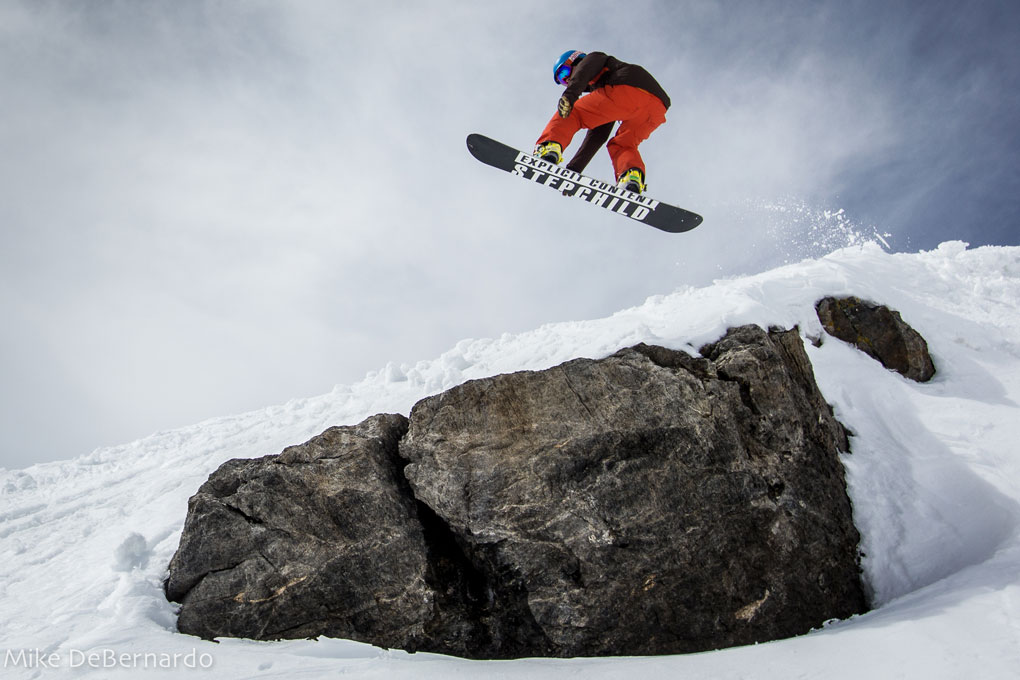Variable Conditions
Riding Snowbird’s Cirque Traverse on the FTW was an absolute blast. While initially counterintuitive to me, its playful, quick turning nature is suited very well to the Cirque’s variable and ever-changing conditions, moguls, etc. (Yes, I know the Cirque is a traverse, but if you can’t have fun on it, you’re doing it wrong.)
Landings
Once arriving at one of the Cirque’s many destinations, like Jaws or Diagonal Chute, it became clear that the FTW likes landing drops. Whether coming down flat or slightly tail heavy, I found that it lands with at least as much or more confidence than any other board from any category that I’ve been on this year, which I wouldn’t typically expect from a full reverse deck.

It’s where those drops typically end, with some sort of bumpy runout or variation of chopped-up snow, that I found the FTW to be a little more work relative to something more damp and / or cambered.
Rather than keeping my weight forward or centered, I found myself leaning a little farther back to absorb the chop rather than plow through it, similar to other rockered boards like the Proto CT. Like the Proto, the tail was stiff enough that when landing off balance in soft snow, all it took was a little more emphasis on the back foot to keep things right side up to avoid the notorious snowboard hip-check.
Powder
Full-reverse decks have an inherent advantage in fresh pow, as they’re already doing much of the work for you in terms of keeping the nose above the snow. Some riders move their bindings back in deeper snow, but I’m much more of a “set it and forget it” rider, and almost never move my bindings once they’re set—in this case, completely centered. With that in mind, I always expect that keeping myself above a bunch of new snow might be a bit of work for my back leg.
So when the spring pow days came to Utah in late March, those non-stop, 2900-foot Tram laps were a little more work and a bit slower on the FTW than on a board like the Venture Odin. But the ride down was much more playful, and I’d much rather be on something playful like the FTW than a big-mountain stick once the pow is hammered on a spring day.

In only one instance in 14 days, in Snowbird’s Wilbere Chute on a particularly deep day, did I find myself digging the nose under the snow unexpectedly and going over the bars. I would attribute this to my centered stance in deep snow and my tendency to keep my weight forward in steep terrain, but I figured it was worth noting.
Durability
In late March, with my confidence inspired by new coverage provided by several days worth of fresh snow, I found myself pointing the FTW directly through Rat’s Nest, usually a minefield of roots and rocks, and typically used to access Great Scott. While I made it through once without incident, I wasn’t so lucky the second time, and took a sharp rock directly underfoot. In this instance, the FTW fared better than I did, coming away without a scratch.
Having spent the same amount of time on the StepChild as my Capita DOA, accessing the same rocky terrain and in very similar conditions, the FTW shows only small, superficial scratching and has fared much better overall. I have little doubt that it would hold up through a full season and more as the only board in my quiver.
Bottom Line
With the StepChild FTW, I was hoping for a fun, playful board to make the most of spring conditions at Snowbird, a board that could handle, if not excel, at anything that this time of year might bring. That’s exactly what I got.
It is marketed as a “high end freestyle machine” by StepChild, a company that claims to have “Bigger Hearts than Brains,” but that seems to have more than enough of both.
The FTW is worth consideration as a one-board quiver for a freestyle-oriented rider who is looking for a deck to take anywhere. While it might not blast through crud like a bigger, heavier, deck, it’s certainly adequate in that regard, and makes the rollers and jibs on the way back to the lift a lot more fun.
